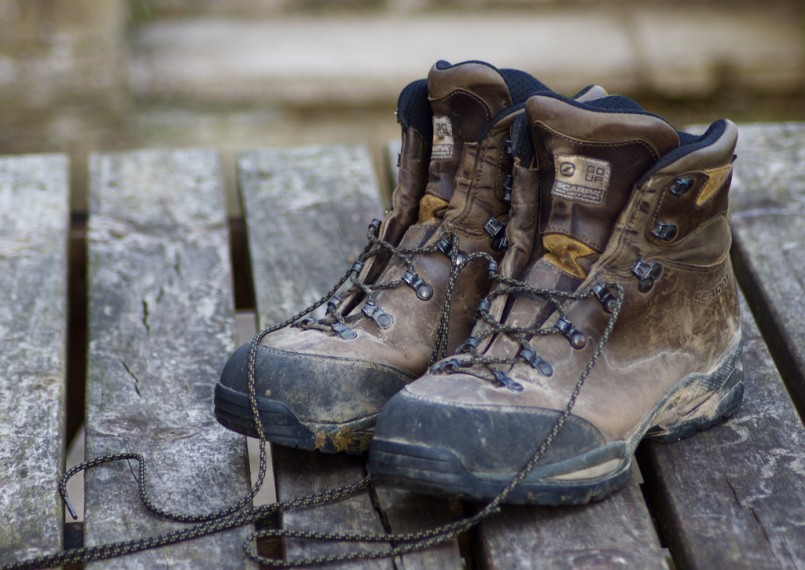
By: Matthew Hillier
Good quality hiking boots are an investment that can be expected to last a long time, but only if you take care of them. This article will tell you how to take proper care of your hiking boots, from breaking them in to having them resoled, so you will get the most value for your investment.
In this article, I will discuss five main points of proper care and maintenance of your hiking boots:
- Breaking them in.
- Waterproofing.
- Cleaning and general maintenance.
- Resoling.
- Knowing when they’ve had it.
- Breaking In your Hiking Boots
The purpose of breaking in your hiking boots is to soften them so they will not hurt your feet. They must be made flexible at exactly the places where your feet and ankles bend. The best way to do this is to walk in them. The goal of breaking in your hiking boots is to do it in short walks, so you don’t find yourself in the middle of the wilderness with blisters and an inflexible pair of hiking boots.
Hiking shoes or day-hiking boots might not need any break-in, but try it just to be sure. Very heavy hiking boots might not actually break in, but wearing them will make your feet grow tougher in the places where the boots refuse to bend.
In either case, what you want to do is to wear your new hiking boots for short periods of time. Wear them around the house, on your morning walk, on your way to work and back (or wear them at work, if your job does not require a lot of walking and if dress codes permit). Wear them on short hikes.
Once the boots are properly broken in, they will feel comfortable as you walk. Then you’re ready to take them on a serious hike.
You may have heard of leaving your new hiking boots out in the weather, or soaking them and wearing them as they dry out, or other drastic and exotic techniques for breaking them in. If it seems like a bad idea, that’s because it is. Break them in gently, and they will last much longer.
Waterproofing your Hiking Boots
Most hiking boots are already waterproof when you buy them, but you still have to do some additional waterproofing. Check the manufacturer’s recommendation, either in documentation that came with the boots or on their Web site.
Different materials require different kinds of waterproofing. Leather, whether full grain or split, requires a wax-based waterproofing compound (which is exactly what shoe polish is). Fabric, especially nylon blends, requires silicone-based waterproofing spray.
Since most hiking boots are made of a combination of leather and fabric, you will have to use both types of waterproofing. And be careful, because the silicone-based sprays can be harmful to the glued seams of leather hiking boots. The best approach for such dual-material hiking boots is to spray the silicone-based waterproofing on the fabric panels while shielding the leather, then spray the wax-based waterproofing on the leather panels and the seams.
If you have full grain leather hiking boots, you can either use a wax-based waterproofing spray or old-fashioned shoe polish. Shoe polish works best on the seams, as you can put it on extra thick and work it into the seams and stitching.
Before you first use them, and after each major hike, clean your boots thoroughly and give them a full waterproofing treatment. Hiking shoes, worn infrequently, might need the waterproofing treatment just once a year or so, but use your judgment. If you see new scuff or wear marks after a hike, reapply the waterproofing.
Cleaning and General Maintenance of your Hiking Boots
Clean off the mud and dust from your hiking boots after each day of hiking. Each time you stop for a major break on a hike, check your boots and remove any excess mud or dust. To clean your boots while hiking or camping, just kick against a rock, bang your boots together, or scrape with a stick if necessary.
If you let the mud dry on your boots, it will both leach out the waterproofing and soak into the boot. This slowly destroys leather, and it’s not good for nylon, either.
Once you get home, or at least every few days on a protracted backpacking trek, wipe your boots with a damp cloth. Be sure to get off all the foreign matter, so there is nothing to interfere with the waterproofing chemicals, and so you can inspect them for damage.
If a seam is coming undone, cut off any dangling threads. If the dangling thread catches on something, the seam will simply come undone that much faster. Depending on the extent of the damage and the cost of the boots, you might want to bring them to a cobbler for repairs, or simply apply extra shoe polish to hold the loose ends in place and to ensure that the seam is waterproof.
If your boots have gotten soaked, dry them out slowly. Rapid drying will make the leather parts shrink and pull away from the fabric parts and from the rubber sole. Pack the damp boots full of wadded newspapers, and replace the newspapers every few hours until the boots are dry.
In between hikes, a pair of shoe trees will help your boots to hold their shape. And this will be very important to your comfort on your next hike.
Resoling your Hiking Boots
If you have a good pair of backpacking boots, you can have the soles replaced when they wear out. This will cost anywhere from $40.00 to $80.00.
Hiking shoes or day-hiking boots are not worth resoling. Generally, the uppers will wear out as fast as the soles, but even if the uppers appear to be in good shape, the cost just doesn’t make sense.
Look for an experienced cobbler in your town to resole your boots. There are services on the Web that will do this, too, but the shipping costs add considerably to the overall cost. The main benefit is that all such services guarantee their work. If you don’t know a cobbler you can trust with your precious hiking boots, search for “boot resole” on the Web.
After your hiking boots have been resoled, they will be like a new pair. That means you must break them in again.
Knowing When your Hiking Boots are Worn Out
Inspect your hiking boots for wear, and recognize when it’s time to replace them or, if they are worth it, to invest in major repairs.
The most obvious wear point is the tread. Sometimes the tread will be visibly worn, such that the cracks between the knobs of the tread are not deep enough to provide traction. On some hiking boots, you will discover that there are two layers within the sole, and after the softer portion wears through, you are walking on a harder inner portion that does not provide good traction on hard rock.
Another common wear point is the inside of the scree collar (the padding around the top that keeps pebbles out without chafing your Achilles tendon). If the lining has worn through and the foam padding has been exposed, your hiking boots must be repaired or replaced promptly.
Check the lining of the sole of your hiking boots. Very often, you will find a hole wearing through under your heel or toe. (Removable insoles can prevent this, but be sure to replace the insoles regularly.) Such a hole will soon begin causing blisters.
In some hiking boots, the uppers will begin to wear at the seams. You may find that the seams are coming apart very rapidly, as friction between the panels makes the fabric weaker, allowing even more movement and more friction.
Hiking shoes and day-hiking boots may fail by the sole separating from the uppers. If this happens before the shoes have begun showing other serious signs of wear, take it as a lesson: Avoid that brand in the future. If it happens in conjunction with other failures, well, it’s just time for a new pair of hiking boots.
If your hiking boots contain both leather and fabric, you may find that the leather has slowly stretched from the constant tension of the laces. The fabric will begin to wrinkle as the leather stretches away from it. Once this begins, seam failure will soon follow.
Another problem with stretching leather is that your hiking boots may reach a point where you can no longer tighten them! I have only seen this once, on a pair of split leather day-hiking boots. (Hated to see them go.)
Full-grain leather, properly cared for, is almost indestructible. If not properly cared for, it will crack. There’s not much you can do but replace the boots, and try to take better care of the next pair.
Conclusion
Take care of your hiking boots, and they’ll take care of you. Keep them clean, waterproof them with the manufacturer’s recommended waterproofing compound, and they will serve you for thousands of miles on the trail.





0 comments